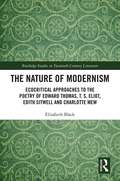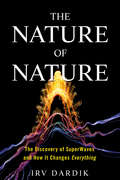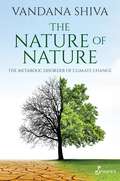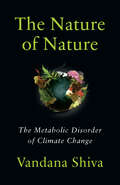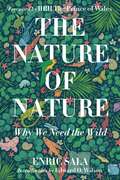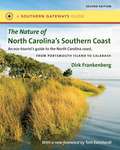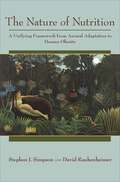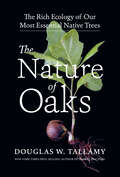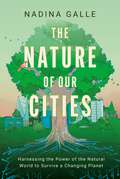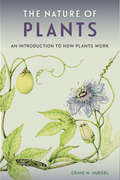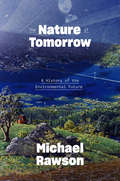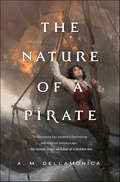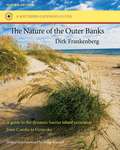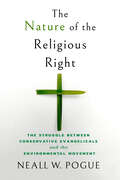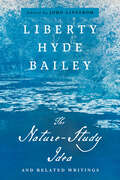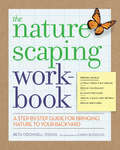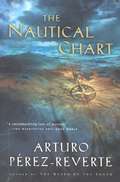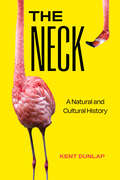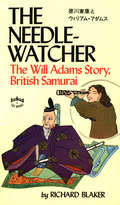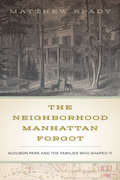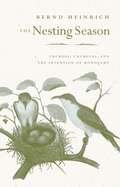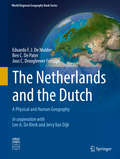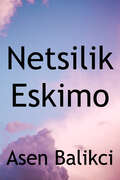- Table View
- List View
The Nature of Modernism: Ecocritical Approaches to the Poetry of Edward Thomas, T. S. Eliot, Edith Sitwell and Charlotte Mew (Routledge Studies in Twentieth-Century Literature)
by Elizabeth BlackThis books presents the first extended study of the relationship between British modernist poetry and the environment. Challenging reductive associations of modernism as predominantly anthropocentric in character and urban in focus, the book’s central argument is that within British modernist poetry there is a clear and sustained interest in the natural world which has yet to receive adequate critical attention. Whilst modernist studies continues to emphasize the plurality of the movement and the breadth of voices and concerns within it, the environmental consciousness of modernist literature and its response to changes to human/nature relations following the experience of war and modernity remain largely unexamined. Exploring British modernist poetry from an ecocritical perspective offers a fresh approach to the movement and its context, and produces original readings of both canonical and more marginalized modernist voices. This book opens by discussing the relationship between modernism and ecocriticism and the benefits of creating a dialogue between the two. It then presents new readings of Edward Thomas, T. S. Eliot, Edith Sitwell, and Charlotte Mew that reveal a shared preoccupation with environmental issues and a common desire to find new ways of achieving physical, psychological, and artistic reconnection with nature. Building on the continuing growth of ecocriticism, this book demonstrates how green approaches to modernist studies can produce new insights into both individual poets and the modernist movement as a whole, making it an essential resource for students of modernism, ecocriticism, and early-twentieth-century literature.
The Nature of Nature: The Discovery of SuperWaves and How It Changes Everything
by Irving Dardik Estee Dardik LichterWhat is everything made of? How do things change and how do they work? What is life? In The Nature of Nature, visionary scientist Irv Dardik tackles these questions by introducing his discovery of SuperWaves, a singular wave phenomenon whose design generates what we experience as matter, space, time, motion, energy, and order and chaos. Simply put, the SuperWaves principle states that the fundamental stuff of nature is waves—waves waving within waves, to be exact. Dardik challenges the rationality of accepting a priori that the universe is made of discrete particles. Instead, by drawing from his own discovery of a unique wave behavior and combining it with scientific facts, he shows that every single thing in existence—from quantum particles to entire galaxies—is waves waving in the unique pattern he calls SuperWaves. The discovery of SuperWaves and the ideas behind it, while profound, can be intuitively grasped by every reader, whether scientist or layperson. Touching on everything from quantum physics to gravity, to emergent complexity and thermodynamics, to the origins of health and disease, it shows that our health, and the health of the environment and civilization, depend upon our understanding SuperWaves. The Nature of Nature is an absorbing account that combines Dardik’s contrarian look at the history of science with philosophical discussion, his own groundbreaking research, and hope for the future.
The Nature of Nature: The Metabolic Disorder of Climate Change
by Vandana ShivaWith her inimitable mix of scholarship and activism, Vandana Shiva lays out the emergency we all face: extinction, climate havoc and the global food crisis. She lays the blame squarely at the feet of the 1%: corporations, polluters and turncoat governments. She challenges the idea that all humans are responsible for this emergency and therefore challenges the term ‘ anthropocene' . Environmental treaties intended to protect the earth have been appropriated and are now being used to create new markets in pollution and massive environmental damage. The Biodiversity Convention (1992) has been undermined and subverted by the same 1%. This is a travesty for the planet and its inhabitants. In a similar fashion, the UN Climate Convention has been turned into a marketplace for trading pollution.
The Nature of Nature: The Metabolic Disorder of Climate Change
by Vandana ShivaIn an age of climate catastrophes and extinction, we need to turn back to nature and learn, once again, how to live sustainably on planet Earth—beginning with our relationship to food.Four billion years ago, Earth was a hot, lifeless planet. Through the process of evolution, the Earth and its diversity of living organisms gradually reduced the amount of carbon in the atmosphere. About 200,000 years ago, the conditions aligned for our own species—Homo sapiens—to emerge and thrive.But what will it take to continue to survive?In The Nature of Nature, world-renowned environmental thinker and activist Vandana Shiva argues that food is the currency of life, a thread woven throughout the web of all life, indivisible from Earth and its natural systems. When this interdependence is ruptured—as it is now—the conditions for the &“metabolic disorder&” of climate change and countless other ecological imbalances come into being.Proposals put forward by Big Ag and Big Tech to solve the intertwined climate and food crises will only exacerbate both. With clarity and a detailed analysis, Shiva unpacks the false promises made by technology-oriented, lab-intensive digital agriculture, revealing the dangers posed by fake and ultra-processed foods—dangers to the environment, to increasing greenhouse gas emissions, to the health of animals, and to our health and food security.In The Nature of Nature, Shiva takes a powerful stand, arguing with urgency and passion for a food and climate future based not on techno-optimism, hallucination, and corporate delusions, but on the natural regeneration of biodiversity in partnership with the biosphere.Praise for Vandana Shiva:&“She&’s been called the &‘Gandhi of grain,&’ the &‘rock star&’ of the anti-GMO movement and an &‘eco-warrior goddess.&’ . . . Above all, [she] is a staunch believer that the food we eat matters. It makes us who we are, physically, culturally and spiritually.&”—BBC
The Nature of Nature: Why We Need the Wild
by Enric SalaIn this inspiring manifesto, an internationally renowned ecologist makes a clear case for why protecting nature is our best health insurance, and why it makes economic sense.Enric Sala wants to change the world--and in this compelling book, he shows us how. Once we appreciate how nature works, he asserts, we will understand why conservation is economically wise and essential to our survival. Here Sala, director of National Geographic's Pristine Seas project (which has succeeded in protecting more than 5 million sq km of ocean), tells the story of his scientific awakening and his transition from academia to activism--as he puts it, he was tired of writing the obituary of the ocean. His revelations are surprising, sometimes counterintuitive: More sharks signal a healthier ocean; crop diversity, not intensive monoculture farming, is the key to feeding the planet.Using fascinating examples from his expeditions and those of other scientists, Sala shows the economic wisdom of making room for nature, even as the population becomes more urbanized. In a sober epilogue, he shows how saving nature can save us all, by reversing conditions that led to the coronavirus pandemic and preventing other global catastrophes. With a foreword from Prince Charles and an introduction from E. O. Wilson, this powerful book will change the way you think about our world--and our future.
The Nature of Nature: Why We Need the Wild
by Enric SalaIn this inspiring manifesto, an internationally renowned ecologist makes a clear case for why protecting nature is our best health insurance, and why it makes economic sense.Enric Sala wants to change the world--and in this compelling book, he shows us how. Once we appreciate how nature works, he asserts, we will understand why conservation is economically wise and essential to our survival. Here Sala, director of National Geographic's Pristine Seas project (which has succeeded in protecting more than 5 million sq km of ocean), tells the story of his scientific awakening and his transition from academia to activism--as he puts it, he was tired of writing the obituary of the ocean. His revelations are surprising, sometimes counterintuitive: More sharks signal a healthier ocean; crop diversity, not intensive monoculture farming, is the key to feeding the planet.Using fascinating examples from his expeditions and those of other scientists, Sala shows the economic wisdom of making room for nature, even as the population becomes more urbanized. In a sober epilogue, he shows how saving nature can save us all, by reversing conditions that led to the coronavirus pandemic and preventing other global catastrophes. With a foreword from Prince Charles and an introduction from E. O. Wilson, this powerful book will change the way you think about our world--and our future.
The Nature of North Carolina's Southern Coast
by Tom Earnhardt Dirk FrankenbergFor some years, The Nature of North Carolina's Southern Coast has stood as an essential resource for all who treasure our coastal environment. In this book, Dirk Frankenberg describes the southern coast's beaches, inlets, and estuaries and instructs readers in the responsible exploration and enjoyment of some of North Carolina's most precious natural areas. From Ocracoke Inlet to the South Carolina border, this field guide provides a close-up look at a complex ecosystem, highlighting the processes that have shaped, and continue to shape, North Carolina's southern coast. Frankenberg identifies over 50 different areas of interest along 180 miles of coastline and presents images to help identify natural processes, plants, and plant communities. In addition, he addresses threats to these fragile coastal areas and possible solutions for these threats. Tom Earnhart's new foreword brings the book up to date, helping us appreciate why a deeper understanding of this environment is crucial to its continued enjoyment.Southern Gateways Guide is a registered trademark of the University of North Carolina Press
The Nature of Nutrition: A Unifying Framework from Animal Adaptation to Human Obesity
by David Raubenheimer Stephen J. SimpsonThe first book to address nutrition's complex role in biologyNutrition has long been considered more the domain of medicine and agriculture than of the biological sciences, yet it touches and shapes all aspects of the natural world. The need for nutrients determines whether wild animals thrive, how populations evolve and decline, and how ecological communities are structured. The Nature of Nutrition is the first book to address nutrition's enormously complex role in biology, both at the level of individual organisms and in their broader ecological interactions.Stephen Simpson and David Raubenheimer provide a comprehensive theoretical approach to the analysis of nutrition—the Geometric Framework. They show how it can help us to understand the links between nutrition and the biology of individual animals, including the physiological mechanisms that determine the nutritional interactions of the animal with its environment, and the consequences of these interactions in terms of health, immune responses, and lifespan. Simpson and Raubenheimer explain how these effects translate into the collective behavior of groups and societies, and in turn influence food webs and the structure of ecosystems. Then they demonstrate how the Geometric Framework can be used to tackle issues in applied nutrition, such as the problem of optimizing diets for livestock and endangered species, and how it can also help to address the epidemic of human obesity and metabolic disease.Drawing on a wealth of examples from slime molds to humans, The Nature of Nutrition has important applications in ecology, evolution, and physiology, and offers promising solutions for human health, conservation, and agriculture.
The Nature of Oaks: The Rich Ecology of Our Most Essential Native Trees
by Douglas W. Tallamy&“A timely and much needed call to plant, protect, and delight in these diverse, life-giving giants.&” —David George Haskell, author of The Forest Unseen and The Songs of Trees With Bringing Nature Home, Doug Tallamy changed the conversation about gardening in America. His second book, the New York Times bestseller Nature&’s Best Hope, urged homeowners to take conservation into their own hands. Now, he is turning his advocacy to one of the most important species of the plant kingdom—the mighty oak tree. Oaks sustain a complex and fascinating web of wildlife. The Nature of Oaks reveals what is going on in oak trees month by month, highlighting the seasonal cycles of life, death, and renewal. From woodpeckers who collect and store hundreds of acorns for sustenance to the beauty of jewel caterpillars, Tallamy illuminates and celebrates the wonders that occur right in our own backyards. He also shares practical advice about how to plant and care for an oak, along with information about the best oak species for your area. The Nature of Oaks will inspire you to treasure these trees and to act to nurture and protect them.
The Nature of Our Cities: Harnessing the Power of the Natural World to Survive a Changing Planet
by Nadina GalleIn the tradition of Elizabeth Kolbert and Michael Pollan, The Nature of Our Cities is a stirring exploration of how innovators from around the world are combining urban nature with emerging technologies, protecting the planet’s cities from the effects of climate change and safeguarding the health of their inhabitants.We live in an age when humanity spends 90% of its time indoors, yet the nature around us—especially in America’s cities—has never been more vital. This distancing from nature has sparked crises in mental health, longevity, and hope for the next generation, while also heightening the risks we face from historic floods, heatwaves, and wildfires. Indeed, embracing nature holds untapped potential to strengthen and fortify our cities, suburbs, and towns, providing solutions spanning flood preparation, wildfire management, and promoting longevity. As ecological engineer Dr. Nadina Galle shows in The Nature of Our Cities nature is our most critical infrastructure for tackling the climate crisis. It just needs a little help. A fellow at MIT’s Senseable City Lab and selected for Forbes’ 30 under 30 list, Galle is at the forefront of the growing movement to fuse nature and technology for urban resilience. In THE NATURE OF OUR CITIES, she embarks on a journey as fascinating as it is pressing, showing how scientists and citizens from around the world are harnessing emerging technologies to unlock the power of the natural world to save their cities, a phenomenon she calls the “Internet of Nature.” Traveling the globe, Galle examines how urban nature, long an afterthought for many, actually points the way toward a more sustainable future. She reveals how technology can help nature navigate this precarious moment with modern advances such as:Laser-mapping that identifies at-risk neighborhoods to fight deadly health disparitiesA.I.-powered robots that prevent wildfires from reaching urban areasIntelligent water gardens that protect cities from floods and hurricanesAdvanced sensors that achieve 99% tree survival in dry, hot summers Optimistic in spirit yet pragmatic in approach, Galle writes persuasively that the future of urban life depends on balancing the natural world with the technology that can help sustain it. By turns clear-eyed and lyrical, THE NATURE OF OUR CITIES marks the emergence of an invigorating, prescient new talent in nature writing.
The Nature of Plants: An Introduction to How Plants Work
by Craig N. HuegelChoice Outstanding Academic Title Florida Book Awards, Bronze Medal for General Nonfiction Plants play a critical role in how we experience our environment. They create calming green spaces, provide oxygen for us to breathe, and nourish our senses. In The Nature of Plants, ecologist and nursery owner Craig Huegel demystifies the complex lives of plants and provides readers with an extensive tour into their workings. Beginning with the importance of light, water, and soil, Huegel describes the process of photosynthesis and how best to position plants to receive optimal sunlight. He explains why plants suffer from overwatering, what essential elements plants need to flourish, and what important soil organisms reside with them. Readers will understand the difference between friendly and hostile bacteria, fungi, and insects. Sections on plant structure and reproduction focus in detail on major plant organs—roots, stems, and leaves—and cover flowering, pollination, fruit development, and seed germination. Huegel even delves into the mysterious world of plant communication, exploring the messages conveyed to animals or other plants through chemical scents and hormones. With color illustrations, photographs, and real-life examples from his own gardening experiences, Huegel equips budding botanists, ecologists, and even the most novice gardeners with knowledge that will help them understand and foster plants of all types.
The Nature of Tomorrow: A History of the Environmental Future
by Michael RawsonAn examination of how Western visions of endless future growth have contributed to the global environmental crisis &“This book does something that is worth doing and that no other scholarly book I know of comes close to doing: tracing the history of imagined environmental futures in the Western world.&”—William Meyer, Colgate University For centuries, the West has produced stories about the future in which humans use advanced science and technology to transform the earth. Michael Rawson uses a wide range of works that include Francis Bacon&’s New Atlantis, the science fiction novels of Jules Verne, and even the speculations of think tanks like the RAND Corporation to reveal the environmental paradox at the heart of these narratives: the single-minded expectation of unlimited growth on a finite planet. Rawson shows how these stories, which have long pervaded Western dreams about the future, have helped to enable an unprecedentedly abundant and technology-driven lifestyle for some while bringing the threat of environmental disaster to all. Adapting to ecological realities, he argues, hinges on the ability to create new visions of tomorrow that decouple growth from the idea of progress.
The Nature of a Pirate (Hidden Sea Tales #3)
by A. M. DellamonicaThe Nature of a Pirate is the third book in acclaimed author, A.M. Dellmonica’s high seas, Stormwrack series. The Lambda Award nominated series begins with Child of a Hidden Sea. Marine videographer and biologist Sophie Hansa has spent the past few months putting her knowledge of science to use on the strange world of Stormwrack, solving seemingly impossible cases where no solution had been found before. When a series of ships within the Fleet of Nations, the main governing body that rules a loose alliance of island nation states, are sunk by magical sabotage, Sophie is called on to find out why. While surveying the damage of the most recent wreck, she discovers a strange-looking creature—a fright, a wooden oddity born from a banished spell—causing chaos within the ship. The question is who would put this creature aboard and why?The quest for answers finds Sophie magically bound to an abolitionist from Sylvanner, her father’s homeland. Now Sophie and the crew of the Nightjar must discover what makes this man so unique while outrunning magical assassins and villainous pirates, and stopping the people responsible for the attacks on the Fleet before they strike again.At the Publisher's request, this title is being sold without Digital Rights Management Software (DRM) applied.
The Nature of the Outer Banks
by Dirk Frankenberg Betsy BennettNorth Carolina's Outer Banks are in constant motion, responding to weather, waves, and the rising sea level. Beaches erode, sometimes taking homes or sections of highway with them into the surf; sand dunes migrate with the wind; and storms open new inlets and dump sand in channels and sounds. A classic guide, The Nature of the Outer Banks describes these dynamic forces and guides visitors to sites where they can see these phenomena in action. In the first section of the book, Dirk Frankenberg highlights three major processes on the Outer Banks: the rising sea level, movement of sand by wind and water, and stabilization of sand by plant life. In the second section, he provides a mile-by-mile field guide to the northern Banks, and in the final section, he alerts readers to the dangers of overdevelopment on the Outer Banks. In a new foreword for this edition, Betsy Bennett documents the ever-more-critical situation of these shifting sands.Southern Gateways Guide is a registered trademark of the University of North Carolina Press
The Nature of the Religious Right: The Struggle between Conservative Evangelicals and the Environmental Movement
by Neall W. PogueIn The Nature of the Religious Right, Neall W. Pogue examines how white conservative evangelical Christians became a political force known for hostility toward environmental legislation. Before the 1990s, this group used ideas of nature to help construct the religious right movement while developing theologically based, eco-friendly philosophies that can be described as Christian environmental stewardship. On the twentieth anniversary of Earth Day in 1990, members of this conservative evangelical community tried to turn their eco-friendly philosophies into action. Yet this attempt was overwhelmed by a growing number in the leadership who made anti-environmentalism the accepted position through public ridicule, conspiracy theories, and cherry-picked science.Through analysis of rhetoric, political expediency, and theological imperatives, The Nature of the Religious Right explains how ideas of nature played a role in constructing the conservative evangelical political movement, why Christian environmental stewardship was supported by members of the community for so long, and why they turned against it so decidedly beginning in the 1990s.
The Nature-Study Idea: And Related Writings (The Liberty Hyde Bailey Library)
by Liberty Hyde BaileyIn The Nature-Study Idea, Liberty Hyde Bailey articulated the essence of a social movement, led by ordinary public-school teachers, that lifted education out of the classroom and placed it into firsthand contact with the natural world. The aim was simple but revolutionary: sympathy with nature to increase the joy of living and foster stewardship of the earth.With this definitive edition, John Linstrom reintroduces The Nature-Study Idea as an environmental classic for our time. It provides historical context through a wealth of related writings, and introductory essays relate Bailey's vision to current work in education and the intersection of climate change and culture. In this period of planetary turmoil, Bailey's ambition to cultivate wonder (in adults as well as children) and lead readers back into the natural world is more important than ever.
The Naturescaping Workbook: A Step-by-Step Guide for Bringing Nature to Your Backyard
by Beth O'Donnell Young Karen BussoliniMuch of modern garden design is about controlling nature to achieve a desired effect. But for the eco-conscious homeowner, the best garden designer is Mother Nature, and following her lead can result in a beautiful low-maintenance landscape that requires fewer resources, attracts natural wildlife, and saves time and money. In The Naturescaping Workbook, author Beth O'Donnell Young sets forth an easy-to-follow, do-it-yourself plan for gardeners of all skill levels. Her step-by-step approach teaches gardeners to understand their own natural habitat and to nurture the native eco-systems that exist in their yard. And the payoff is huge. By simply becoming aware of the natural wonders in the backyard, anyone can gain a more beautiful garden and take a big step toward bringing nature home.
The Nautical Chart
by Arturo Pérez-ReverteA fearless Spanish crew embarks on a search for a lost ship, swallowed by the Indian Ocean centuries ago, in a novel by &“a master of the literary thriller&” (Booklist, starred review). Manuel Coy is a suspended sailor with time on his hands, a mariner without a ship. While attending a maritime auction in Barcelona, he meets Tánger Soto, a captivating beauty who works for the Naval Museum in Madrid. A woman obsessed with the Dei Gloria, a famed Jesuit ship sunk by pirates in the seventeenth century, she now hopes to find it and unearth its mysteries, rumored to be buried the bottom of the sea off the southern coast of Spain. Quickly drawn into the search, Coy accompanies Tánger Soto, and a wise old man of the sea whose sailboat will carry the crew into the middle of nowhere in search of a fortune. But more than treasure is rising to the surface—secrets are, too. And from these depths will also come danger, and an adventure no one is prepared for. From the acclaimed author of The Queen of the South, The Nautical Chart is &“a swashbuckling tale of mystery&” (The Washington Post Book World).
The Neck: A Natural and Cultural History
by Kent DunlapA 300-million-year tour of the prominent role of the neck in animal evolution and human culture. Humans give a lot of attention to the neck. We decorate it with jewelry and ties, kiss it passionately, and use it to express ourselves in word and song. Yet, at the neck, people have also shackled their prisoners, executed their opponents, and slain their victims. Beyond the drama of human culture, animals have evolved their necks into a staggering variety of shapes and uses vital to their lifestyles. The Neck delves into evolutionary time to solve a living paradox—why is our neck so central to our survival and culture, but so vulnerable to injury and disease? Biologist Kent Dunlap shows how the neck's vulnerability is not simply an unfortunate quirk of evolution. Its weaknesses are intimately connected to the vessels, pipes, and glands that make it so vital to existence. Fun and far-reaching, The Neck explores the diversity of forms and functions of the neck in humans and other animals and shows how this small anatomical transition zone has been a locus of incredible evolutionary and cultural creativity.
The Needle-Watcher
by Richard BlakerThis fascinating novel reconstructs the story of Will Adams, a native of Gillingham, in Kent, England, and his voyage to Japan in the seventeenthcentury. His knowledge of seafaring vessels at the time causes him to be taken into the favor of the shogun Tokugawa Ieyasu and,in time,to become recognized as the founder of the Japanese navy. Adams was one of the most picturesque anddaring of Britain's maritime traders, and this depiction of him as the first Englishman to settle in what was then a hostile country is written not only with distinction but also with an imaginative grasp that takes it right out ofthe class of the ordinary historical novel. It is an epic tale of strange adventures, and it creates an atmosphere of rare and haunting quality. In its understanding of the Japanese mind it is hardly less than remarkable.Will Adams died in Japan in the spring of 1620 and is buried at Yokosuka. Every year aceremony is still held to commemorate the anniversary of his death. There is also a memorial to him at Ito,in Shizuoka Prefecture, as well as one at his birthplace in England. In view of the importance of Japan in the present world picture, this republication of Richard Blaker's splendid novel will no doubtbe a welcome event to all discerning readers.
The Needle-Watcher
by Richard BlakerThis fascinating novel reconstructs the story of Will Adams, a native of Gillingham, in Kent, England, and his voyage to Japan in the seventeenthcentury. His knowledge of seafaring vessels at the time causes him to be taken into the favor of the shogun Tokugawa Ieyasu and,in time,to become recognized as the founder of the Japanese navy. Adams was one of the most picturesque anddaring of Britain's maritime traders, and this depiction of him as the first Englishman to settle in what was then a hostile country is written not only with distinction but also with an imaginative grasp that takes it right out ofthe class of the ordinary historical novel. It is an epic tale of strange adventures, and it creates an atmosphere of rare and haunting quality. In its understanding of the Japanese mind it is hardly less than remarkable.Will Adams died in Japan in the spring of 1620 and is buried at Yokosuka. Every year aceremony is still held to commemorate the anniversary of his death. There is also a memorial to him at Ito,in Shizuoka Prefecture, as well as one at his birthplace in England. In view of the importance of Japan in the present world picture, this republication of Richard Blaker's splendid novel will no doubtbe a welcome event to all discerning readers.
The Neighborhood Manhattan Forgot: Audubon Park and the Families Who Shaped It
by Matthew SpadyAudubon Park’s journey from farmland to cityscapeThe study of Audubon Park’s origins, maturation, and disappearance is at root the study of a rural society evolving into an urban community, an examination of the relationship between people and the land they inhabit. When John James Audubon bought fourteen acres of northern Manhattan farmland in 1841, he set in motion a chain of events that moved forward inexorably to the streetscape that emerged seven decades later. The story of how that happened makes up the pages of The Neighborhood Manhattan Forgot: Audubon Park and the Families Who Shaped It.With a colorful cast of characters drawn from the upper crust of nineteenth-century New York City, this fully illustrated history peels back the many layers of a rural society evolving into an urban community, enlivened by the people who propelled it forward: property owners, tenants, laborers, and servants. Thoroughly researched through primary and secondary sources, as well as private collections, The Neighborhood Manhattan Forgot tells the intricate tale of how individual choices in the face of family dysfunction, economic crises, technological developments, and the myriad daily occurrences that elicit personal reflection and change of course pushed Audubon Park forward to the cityscape that distinguishes the neighborhood today. A longtime evangelist for Manhattan’s Audubon Park neighborhood, author Matthew Spady delves deep into the lives of the two families most responsible over time for the anomalous arrangement of today’s streetscape: the Audubons and the Grinnells. Buoyed by his extensive research, Spady reveals the darker truth behind John James Audubon (1785–1851), a towering patriarch who consumed the lives of his family members in pursuit of his own goals. He then narrates how fifty years after Audubon’s death, George Bird Grinnell (1849–1938) and his siblings found themselves the owners of extensive property that was not yielding sufficient income to pay taxes, insurance, and maintenance. Like the Audubons, they planned an exit strategy for controlled change that would have an unexpected ending. Beginning with the Audubons’ return to America in 1839, The Neighborhood Manhattan Forgot follows the many twists and turns of the area’s path from forest to city, ending in the twenty-first century with the Audubon name repurposed in today’s historic district, a multi-ethnic, multi-racial urban neighborhood far removed from the homogeneous, Eurocentric Audubon Park suburb.
The Nesting Season: Cuckoos, Cuckolds, and the Invention of Monogamy
by Bernd HeinrichWhy are the eggs of the marsh wren deep brown, the winter wren's nearly white, and the gray catbird's a brilliant blue? And what in the DNA of a penduline tit makes the male weave a domed nest of fibers and the female line it with feathers, while the bird-of-paradise male builds no nest at all, and his bower-bird counterpart constructs an elaborate dwelling? These are typical questions that Bernd Heinrich pursues in the engaging style we've come to expect from him supplemented here with his own stunning photographs and original watercolors. One of the world's great naturalists and nature writers, Heinrich shows us how the sensual beauty of birds can open our eyes to a hidden evolutionary process. Nesting, as Heinrich explores it here, encompasses what fascinates us most about birds from their delightful songs and spectacular displays to their varied eggs and colorful plumage; from their sex roles and mating rituals to nest parasitism, infanticide, and predation. What moves birds to mate and parent their young in so many different ways is what interests Heinrich and his insights into the nesting behavior of birds has more than a little to say about our own.
The Netherlands and the Dutch: A Physical and Human Geography (World Regional Geography Book Series)
by Eduardo F. De Mulder Ben C. De Pater Joos C. Droogleever Fortuijn Len A. De Klerk Jerry Van DijkThis book presents a geographical survey of the Netherlands, reviewing recent and historic developments that made the nation. It is a relatively wealthy country and the Dutch belong to the happiest and healthiest on earth. But these qualities are not evenly spread over the country. The urban agglomeration of Randstad Holland in the west hosts most of the nation’s capital and young, well-educated people whereas older and less-educated people are concentrated in the peripheral areas in the north, east and south. Interactions between physical and human geographical aspects of the Netherlands are described quite extensively. Its position on one of Europe’s most prominent deltas, its abundance of energy resources and the course of history have all contributed to its present national position and international networks. But early and recent Dutch have also shaped this country. They reclaimed lakes and shallow seas, protected the lowlands against floods, re-allotted land parcels and designed and developed urban areas. Besides its focus on water-related topics, the book also covers social and cultural aspects. The book also discusses future challenges and offers scenarios for solutions. This is a book for those interested in a wide variety of recent aspects of the geography of the Netherlands described in a historical context. It appeals to students and researchers of many disciplines in geography, urban and landscape planning, water management, history and cultural studies.
The Netsilik Eskimo
by Asen BalikciThis book preserves the traditional way of life of the Netsilik Eskimo "People of the Seal" who lived close to the Arctic Circle in one of the harshest and most demanding environments known to man.
